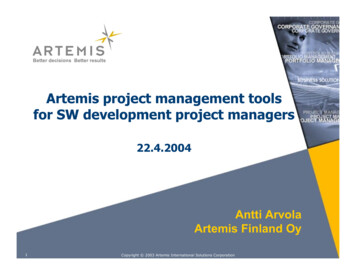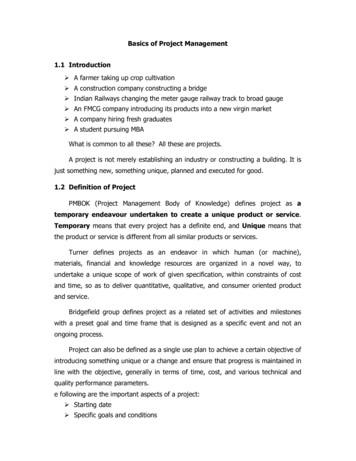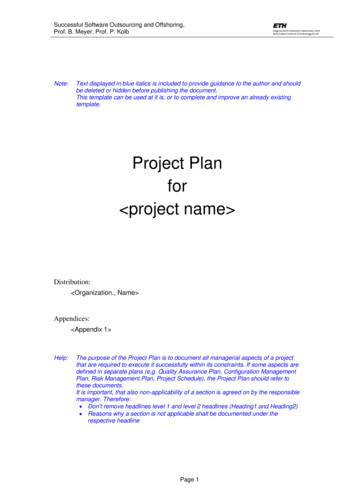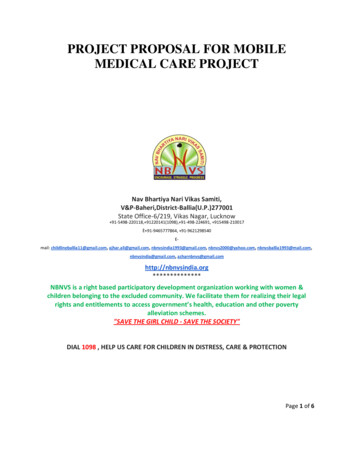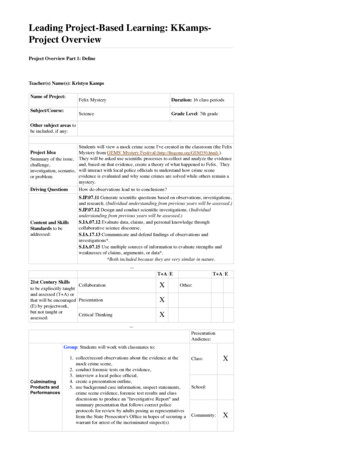
Transcription
iNote: This file includes only chapter 1as a preview of the book.An Introduction to ProjectManagement, Sixth EditionWith a Brief Guide to Microsoft ProjectProfessional 2016ByKathy SchwalbeProfessor Emeritus, Augsburg CollegeDepartment of Business AdministrationMinneapolis, Minnesota
iiAn Introduction toProject Management, Sixth EditionCover Photo: Dan Schwalbe 2017 Schwalbe PublishingISBN-13: 978-1544701899ISBN-10: 1544701896ALL RIGHTS RESERVED. No part of this work covered by the copyright hereon may bereproduced, transmitted, stored, or used in any form or by any means graphic, electronic, ormechanical, including but not limited to photocopying, recording, scanning, digitizing, taping,Web distribution, information networks, or information storage and retrieval systems, except aspermitted under Section 107 or 108 of the 1976 United States Copyright Act, without the priorwritten permission of the author.Materials from Kathy Schwalbe’s Information Technology Project Management are used withpermission from Cengage Learning.Microsoft and the Office logo are either registered trademarks or trademarks of MicrosoftCorporation in the United States and/or other countries. All screenshots from Microsoftproducts are used with permission from Microsoft.Information and screenshots from MindView are used with permission from MatchWare.Information and screenshots from Basecamp are used with permission from Basecamp.Some of the product names and company names used in this book have been used foridentification purposes only and may be trademarks or registered trademarks of their respectivemanufacturers and sellers.This publication is a derivative work of A Guide to the Project Management Body of Knowledge(PMBOK Guide) – Sixth Edition, which is copyrighted material of and owned by, ProjectManagement Institute, Inc. (PMI), Copyright 2017. This publication has been developed andreproduced with the permission of PMI. Unauthorized reproduction of this material is strictlyprohibited. The derivative work is the copyrighted material of and owned by, SchwalbePublishing, Copyright 2017.PMI, PMP, CAPM, OPM3, and PMBOK are registered marks of the Project ManagementInstitute, Inc.Published by Schwalbe Publishing in Minneapolis, MN, September 2017.Free companion website at www.intropm.com.Visit www. pmtexts.com or www.kathyschwalbe.com for more information on this andother books by Kathy Schwalbe.
iiiFor Dan, Anne, Bobby, and ScottMy husband and children continue to be my inspiration.My son-in-law, Jeremy, and grandson, Freddie,are welcome additions to our family!
ivBRIEF TABLE OF CONTENTSChapter 1An Introduction to Project, Program, andPortfolio Management1Chapter 2Project, Program, and Portfolio Selection37Chapter 3Initiating Projects71Chapter 4Planning Projects, Part 1 (Project Integrationand Scope Management)112Chapter 5Planning Projects, Part 2 (Project Time and Cost 147Management)Chapter 6Planning Projects, Part 3 (Project Quality,Resource, Communications, Stakeholder, Risk,and Procurement Management)190Chapter 7Executing Projects243Chapter 8Monitoring and Controlling Projects299Chapter 9Closing Projects339Chapter 10Best Practices in Project Management361Appendix ABrief Guide to Microsoft Project 2016389Appendix BResources452Appendix CCase Studies460Glossary479Index488
Chapter 1 – Introduction (Copyright 2017 Schwalbe Publishing)1Chapter 1An Introduction to Project,Program, and PortfolioManagementLEARNING OBJECTIVESAfter reading this chapter, you will be able to: Understand the growing need for better project, program, and portfoliomanagement Explain what a project is, provide examples of projects, list various attributes ofprojects, and describe project constraints Describe project management and discuss key elements of the project managementframework, including project stakeholders, the project management knowledgeareas, common tools and techniques, project success factors, and project benefitsmeasurement Discuss the relationship between project, program, and portfolio management andtheir contributions to enterprise success Describe the project management profession, including the role of projectmanagers and suggested skills, the role of professional organizations like the ProjectManagement Institute, the importance of certification and ethics, projectmanagement careers, and the growth of project and portfolio management software
2Chapter 1 – Introduction (Copyright 2017 Schwalbe Publishing)OPENING CASEDoug Milis, the Chief Executive Officer (CEO) of Global Construction, Inc., was summarizingannual corporate highlights to the board of directors. Like many other large construction companies,they had a very difficult year. After having scaled down operations a few years ago, this past year theyhad trouble finding enough qualified workers to meet the growing demand for new construction.When one of the board members asked what he was most proud of that year, Doug thought for afew seconds, and then replied,“Excellent question, Gabe. Honestly, I think the main reason we survived this year wasbecause we are truly a project-based organization. We have dramatically improved our ability toquickly select and implement projects that help our company succeed and cancel or redirect otherprojects. All our projects align with our business strategies, and we have consistent processes in placefor getting things done. We can also respond quickly to market changes, unlike many of ourcompetitors. Marie Scott, our Director of the Project Management Office (PMO), has done anoutstanding job in making this happen. And believe me, it was not easy. It’s never easy to implementchanges across an entire company. But with this new capability to manage projects across theorganization, I am very confident that we will have continued success in years to come.”INTRODUCTIONMany people and organizations today have a new or renewed interest in project management.In the past, project management primarily focused on providing schedule and resource data totop management in just a few industries, such as the military and construction industries.Today’s project management involves much more, and people in every industry and everycountry manage projects. New technologies have become a significant factor in manybusinesses, and the use of interdisciplinary and global work teams has radically changed thework environment. The facts below demonstrate the significance of project management: Demand for projects continues to increase, with GDP contributions from projectoriented industries forecasted to be US 20.2 trillion by 2017. Employers will need 87.7million individuals working in project management-oriented roles by 2027. “The talentgap could result in a potential loss of some US 207.9 billion in GDP through 2027.”1 “Job Outlook 2017” says the market is good for college graduates who demonstratethe most important attribute employers want: the ability to work as part of a team.2 Organizations waste 97 million for every 1 billion spent on projects, according toProject Management Institute’s (PMI’s) 2017 Pulse of the Profession report. Thatrepresents a 20% improvement from the previous year. Organizations realize thatexcelling at project management definitely affects the bottom line.3 The United States (U.S.) signed The Program Management Improvement andAccountability Act (PMIAA) into law in December 2016 to enhance best practices inproject and program management throughout the federal government. In 2015, the average salary for someone in the project management profession in U.S.dollars was 108,200 per year in the U.S.; 134,000 in Switzerland, (the highest-paid
Chapter 1 – Introduction (Copyright 2017 Schwalbe Publishing)3country); and 19,602 in Egypt (the lowest-paid country). These average salaries do notinclude bonuses. The average total compensation for project management workers inthe U.S., for example, was 130,000. Of the 9,677 people from the U.S. who respondedto PMI’s salary survey, 81% had the Project Management Professional (PMP )credential, and their salary was over 22% higher than those without it. This data isbased on responses from over 26,000 people in 34 countries.4 It is also interesting to note that 38% of the salary survey respondents were women,11% had a degree in project management, and the project management department orProject Management Office (PMO) was the department most listed at 31%.5Project management is also a vital skill for personal success. Managing a family budget,planning a wedding, remodeling a house, completing a college degree, and many otherpersonal projects can benefit from good project management.WHAT WENT WRONG?In 1995, the Standish Group published an often-quoted study entitled “CHAOS.” This prestigiousconsulting firm surveyed 365 information technology (IT) executive managers in the U.S. whomanaged more than 8,380 IT application projects. As the title of the study suggests, the projects werein a state of chaos. U.S. companies spent more than 250 billion each year in the early 1990s onapproximately 175,000 IT application development projects. Examples of these projects includedcreating a new database for a state department of motor vehicles, developing a new system for carrental and hotel reservations, and implementing a client-server architecture for the banking industry.Their study reported that the overall success rate of IT projects was only 16.2 percent. The surveyorsdefined success as meeting project goals on time and on budget.The study also found that more than 31 percent of IT projects were canceled beforecompletion, costing U.S. companies and government agencies more than 81 billion. The authors ofthis study were adamant about the need for better project management in the IT industry. Theyexplained, “Software development projects are in chaos, and we can no longer imitate the threemonkeys—hear no failures, see no failures, speak no failures.” 6In a later study, PricewaterhouseCoopers surveyed 200 companies from 30 differentcountries about their project management maturity and found that over half of all projects failed.They also found that only 2.5 percent of corporations consistently met their targets for scope,schedule, and cost goals for all types of projects. These statistics made people understand the need toimprove the practice of project management.7Although several researchers question the methodology of the CHAOS studies, theirpopularity has prompted organizations throughout the world to examine their practices inmanaging projects. Managers are recognizing that to be successful, they need to be conversantwith and use modern project management techniques. People from all types of disciplines—science, liberal arts, education, business, etc.—can benefit from basic project managementprinciples. Individuals are realizing that to remain competitive, they must develop skills toeffectively manage the professional and personal projects they undertake. They also realize thatmany of the concepts of project management, especially interpersonal skills, will help them asthey work with people on a day-to-day basis.
4Chapter 1 – Introduction (Copyright 2017 Schwalbe Publishing)Organizations claim that using project management provides advantages, such as: Better control of financial, physical, and human resources Improved customer relations Shorter development times Lower costs Higher quality and increased reliability Higher profit margins Improved productivity Better internal coordination Higher worker moraleIn addition to project management, organizations are embracing program and portfoliomanagement to address enterprise-level needs. This chapter introduces projects and projectmanagement, describes the differences between project, program, and portfolio management,discusses the role of the project manager, and provides important background information onthis growing profession.WHAT IS A PROJECT?To discuss project management, it is important to understand the concept of a project. Aproject is “a temporary endeavor undertaken to create a unique product, service, or result.”8Operations, on the other hand, is work done in organizations to sustain the business. Projectsare different from operations in that they end when their objectives have been reached or theproject has been terminated.Examples of ProjectsProjects can be large or small and involve one person or thousands of people. They can bedone in one day or take years to complete. Examples of projects include the following: A young couple hires a firm to design and build them a new house A retail store manager works with employees to display a new clothing line A college campus upgrades its technology infrastructure to provide wirelessInternet access A medical technology firm develops a device that connects to smart phones A school implements new government standards for tracking student achievement A group of musicians starts a company to help children develop their musicaltalents A pharmaceutical company launches a new drug A television network develops a system to allow viewers to vote for contestantsand provide other feedback on programs The automobile industry develops standards for electric cars A government group develops a program to track child immunizations
Chapter 1 – Introduction (Copyright 2017 Schwalbe Publishing)5VIDEO HIGHLIGHTSPMI recognizes outstanding performance in project management by announcing a Project ofthe Year award winner. Their website lists winners since 1989, and videos summarize severalaward-winning projects, such as the following: 2016: National Synchrotron Light Source II, New York USA 2015: El Segundo Refinery Coke Drum Reliability Project, California USA 2014: AP60 Phase 1 Project, Jonquiere, Quebec, CanadaYou can also see how project management was used on much older projects. MarkKozak-Holland wrote a book in 2011 called “The History of Project Management.” Indescribing his book, the a
06.09.2017 · Accountability Act (PMIAA) into law in December 2016 to enhance best practices in project and program management throughout the federal government. In 2015, the



